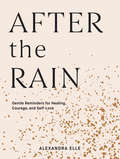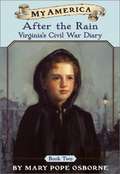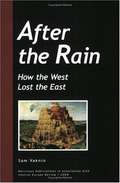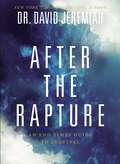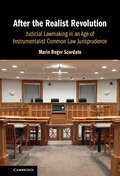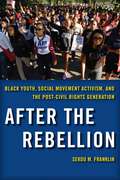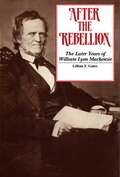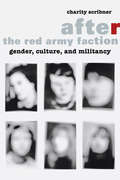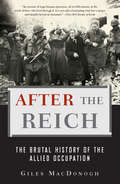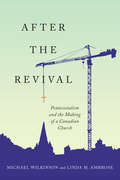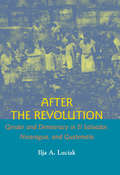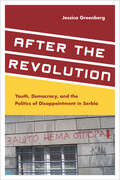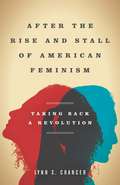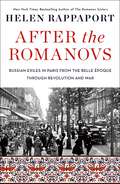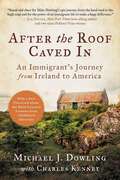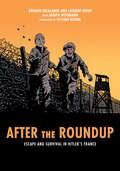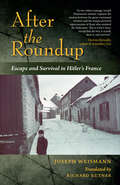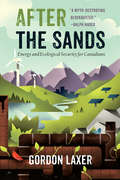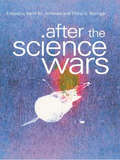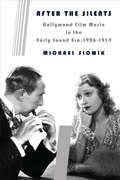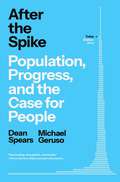- Table View
- List View
After the Rain: Gentle Reminders for Healing, Courage, and Self-Love
by Alexandra ElleIn After the Rain, celebrated self-care storyteller Alexandra Elle delivers 15 lessons on how to overcome obstacles, build confidence, and cultivate abundance.Part memoir and part guide, Elle shares stirring stories from her own remarkable journey from self-doubt to self-love.This soulful collection is filled with illuminating reflections on loss, fear, bravery, healing, love, acceptance, and more.• Readers follow along her journey as she transforms challenging experiences—a difficult childhood, painful romantic relationships, and single parenting as a young mom—into fuel for her career as a successful entrepreneur and author driven by purpose and pasion• Filled with Elle's signature candor and warmth• Includes empowering affirmations and meditations for readers to practice in their own livesAfter the Rain is a soulful guide to help you embrace all the beauty, love, and opportunity life has to offer.• Presented in luminous package with a foil case and gold accents• A beautiful gift for anyone on the path to self-discovery, and an uplifting reminder that there is always sunshine after the rain• Perfect for the friend who loves meditating, self-care, journaling, or seeking personal transformation and empowerment• Great for those who loved Present Over Perfect by Shauna Niequist, 100 Days to Brave by Annie F. Downs, and anything written by Brené Brown, Rupi Kaur, Rachel Hollis, and Elizabeth Gilbert
After the Rain: Virginia's Civil War Diary Book 2 (My America Series)
by Mary Pope OsborneIn the final months of the Civil War, Virginia and her family move to Washington, D.C. where the cold winter brings uncertainty and hardship. Virginia takes a job as a servant in a wealthy home to help her family. But, just as things start to improve as her father gets a job, and the war finally comes to an end, the tragic assassination of Ginny's beloved President Lincoln occurs. In this, her second diary chronicling the Civil War, Ginny learns that life is constantly changing. Indeed, even as Lincoln dies, her nephew is born. Throughout, Ginny faces life with hope and courage.
After the Rain: how the West lost the East
by Samuel VakninAn anthology of more than 50 articles regarding the politics, economics, geopolitics and history of countries in central and eastern Europe and the Balkans.
After the Rapture: An End Times Guide to Survival
by Dr. David JeremiahStop. Drop everything. Nothing is more important for you to understand right now than this! One day soon, everyone, everywhere will be wondering, what on earth just happened?But these future events need not be an inexplicable mystery. The coming Rapture will be an amazing fulfillment of biblical prophecy--one that has been eagerly awaited by Bible-believing Christians since Jesus&’ ascension into heaven.Though many are ready, many more are not. And there&’s a great deal of confusion about the Rapture—and its aftermath--even among those who will be caught up in the air with Christ.After the Rapture presents the perfect primer for you on this critical prophetic event, the ideal witnessing tool for unsaved loved ones, and a resource of biblical direction for those seeking answers in the future. Inside this paperback volume you&’ll find:A detailed look at what the Rapture is, how it happens, and what happens afterward.Eye-opening sections on the Rapture, Judgment Day, and the Great Tribulation.The information you need to clear up your own confusion and prepare for Christ&’s return.A unique, compelling way to share Jesus with those in danger of being left behind.Valuable questions and answers, Scripture verses, life application, and more!This is NOT a work of fiction. In these pages, you won&’t find speculation . . . but rather a pure and detailed description straight from Scripture about what life will be like After the Rapture.
After the Realist Revolution: Judicial Lawmaking in an Age of Instrumentalist Common Law Jurisprudence
by Marin Roger ScordatoAfter the Realist Revolution extends the existing academic study of American common law into new and previously unexplored areas. Marin Scordato examines the conventional understanding of appellate court lawmaking and the profound change in the common understanding of that activity that occurred during the mid-twentieth century. Scordato argues that this change in the conventional account of common law can be best understood as an authentic paradigm shift, akin to those described by Thomas Kuhn in The Structure of Scientific Revolutions. The book also sheds light on the ways in which the current instrumentalist approach to appellate court lawmaking is influenced and, in some respects, compromised by the structures and procedures that were created during the prior formalist era. Thorough and insightful, After the Realist Revolution is an ideal resource for legal scholars and general readers interested in the nature and evolution of American common law.
After the Rebellion: Black Youth, Social Movement Activism, and the Post-Civil Rights Generation
by Sekou M. FranklinAn essential examination of black youth activism since the passage of the 1964 Civil Rights ActWhat happened to black youth in the post-civil rights generation? What kind of causes did they rally around and were they even rallying in the first place? After the Rebellion takes a close look at a variety of key civil rights groups across the country over the last 40 years to provide a broad view of black youth and social movement activism. Based on both research from a diverse collection of archives and interviews with youth activists, advocates, and grassroots organizers, this book examines popular mobilization among the generation of activists—principally black students, youth, and young adults—who came of age after the passage of the 1964 Civil Rights Act and the Voting Rights Act of 1965. Franklin argues that the political environment in the post-Civil Rights era, along with constraints on social activism, made it particularly difficult for young black activists to start and sustain popular mobilization campaigns. Building on case studies from around the country—including New York, the Carolinas, California, Louisiana, and Baltimore—After the Rebellion explores the inner workings and end results of activist groups such as the Southern Negro Youth Congress, Student Nonviolent Coordinating Committee, the Student Organization for Black Unity, the Free South Africa Campaign, the New Haven Youth Movement, the Black Student Leadership Network, the Juvenile Justice Reform Movement, and the AFL-CIO’s Union Summer campaign. Franklin demonstrates how youth-based movements and intergenerational campaigns have attempted to circumvent modern constraints, providing insight into how the very inner workings of these organizations have and have not been effective in creating change and involving youth. A powerful work of both historical and political analysis, After the Rebellion provides a vivid explanation of what happened to the militant impulse of young people since the demobilization of the civil rights and black power movements—a discussion with great implications for the study of generational politics, racial and black politics, and social movements.
After the Rebellion: The Later Years of William Lyon Mackenzie
by Lilian F. GatesThis comprehensive book on William Lyon Mackenzie’s later life focuses first on the period 1838-1849, Mackenzie’s years in exile in the United States. It examines his contribution to the American political scene, including his role in writing the constitution of the State of New York. The book also chronicles Mackenzie’s life from 1849, when he was granted amnesty and returned to Canada, to his death in 1861. In this, the only comprehensive look at Mackenzie’s life, Lillian Gates offers a meticulous account of one of Canada’s liveliest nineteenth century politicians.
After the Red Army Faction
by Charity ScribnerAnalyzing the afterimage of revolutionary violence in contemporary culture and politics. Utopia or Auschwitz: Germany's 1968 Generation and the Holocaust
After the Red Army Faction: Gender, Culture, and Militancy
by Charity ScribnerMasterminded by women, the Red Army Faction (RAF) terrorized West Germany from the 1970s to the 1990s. Afterimages of its leaders persist in the works of pivotal artists and writers, including Gerhard Richter, Elfriede Jelinek, and Slavoj i ek. Why were women so prominent in the RAF? What does the continuing cultural response to the German armed struggle tell us about the representation of violence, power, and gender today? Engaging critical theory, Charity Scribner addresses these questions and analyzes signal works that point beyond militancy and terrorism. This literature and art discloses the failures of the Far Left and registers the radical potential that RAF women actually forfeited.After the Red Army Faction maps out a cultural history of militancy and introduces "postmilitancy" as a new critical term. <P><P>As Scribner demonstrates, the most compelling examples of postmilitant culture don't just repudiate militancy: these works investigate its horizons of possibility, particularly on the front of sexual politics. Objects of analysis include as-yet untranslated essays by Theodor Adorno and Jürgen Habermas, as well as novels by Friedrich Dürrenmatt and Judith Kuckart, Johann Kresnik's Tanztheaterstück Ulrike Meinhof, and the blockbuster exhibition Regarding Terror at the Berlin Kunst-Werke. Scribner focuses on German cinema, offering incisive interpretations of films by Margarethe von Trotta, Volker Schlöndorff, and Fatih Akin, as well as the international box-office success The Baader-Meinhof Complex. These readings disclose dynamic junctures among several fields of inquiry: national and sexual identity, the disciplining of the militant body, and the relationship between mass media and the arts.
After the Reich: The Brutal History of the Allied Occupation
by Giles MacdonoghWhen Hitler's government collapsed in 1945, Germany was immediately divided up under the control of the Allied Powers and the Soviets. A nation in tatters, in many places literally flattened by bombs, was suddenly subjected to brutal occupation by vengeful victors. According to recent estimates, as many as two million German women were raped by Soviet occupiers. General Eisenhower denied the Germans access to any foreign aid, meaning that German civilians were forced to subsist on about 1,200 calories a day. (American officials privately acknowledged at the time that the death rate amongst adults had risen to four times the pre-war levels; child mortality had increased tenfold). With the authorization of President Franklin Delano Roosevelt, over four million Germans were impressed into forced labor. General George S. Patton was so disgusted by American policy in post-war Germany that he commented in his diary, "It is amusing to recall that we fought the revolution in defense of the rights of man and the civil war to abolish slavery and have now gone back on both principles" Although an astonishing 2. 5 million ordinary Germans were killed in the post-Reich era, few know of this traumatic history. There has been an unspoken understanding amongst historians that the Germans effectively got what they deserved as perpetrators of the Holocaust. First ashamed of their national humiliation at the hands of the Allies and Soviets, and later ashamed of the horrors of the Holocaust, Germans too have remained largely silent - a silence W. G. Sebald movingly described in his controversial book On the Natural History of Destruction. In After the Reich, Giles MacDonogh has written a comprehensive history of Germany and Austria in the postwar period, drawing on a vast array of contemporary first-person accounts of the period. In doing so, he has finally given a voice the millions of who, lucky to survive the war, found themselves struggling to survive a hellish "peace. " A startling account of a massive and brutal military occupation, After the Reich is a major work of history of history with obvious relevance today.
After the Revival: Pentecostalism and the Making of a Canadian Church
by Michael Wilkinson and Linda M. AmbroseEarly Pentecostal revivals swept through Canadian communities, big and small, in the early 1900s. Reports abounded of worshippers falling down at the altar, speaking in tongues, having dreams and visions, and experiencing divine healing. Tent meetings inspired curious onlookers to witness these phenomena for themselves. Following these revival meetings, Pentecostals organized, built churches, and expanded across the country, while many churches were beginning to decline. How did these Pentecostal "holy rollers" move from the fringe to take centre stage in Canada's religious landscape? Why is a religious group rooted in the early twentieth century, tied to Methodism and the Holiness movement, still so popular among followers from all walks of life, especially Indigenous peoples and new Canadians? In After the Revival Michael Wilkinson and Linda Ambrose ask these and other questions, arguing that the answers are tied to Pentecostalism's continued organizational efforts. Since 1919, the Pentecostal Assemblies of Canada (PAOC) has worked to establish order and steady growth by managing financial and material assets, offering programs designed to attract families and youth, and training leaders. While Pentecostalism sometimes reflects broader cultural trends and at other times resists them, the PAOC has grown steadily to become one of the largest evangelical denominations in Canada. Addressing broader questions about how religious movements organize, establish an identity, and develop a subculture that flourishes, After the Revival explores the fascinating history of Pentecostalism in Canada and the ways the church, represented by the PAOC, engages with Canadian society.
After the Revolution: Gender and Democracy in El Salvador, Nicaragua, and Guatemala
by Ilja A. LuciakHow women active in guerilla movements become active in politics after the war. Complements Bayard de Volo's Mothers, Heroes, Martyrs:Gender Identity Politics in Nicaragua, 1979–1999."Gender equality and meaningful democratization are inextricably linked," writes Ilja Luciak. "The democratization of Central America requires the full incorporation of women as voters, candidates, and office holders." In After the Revolution: Gender and Democracy in El Salvador, Nicaragua, and Guatemala, Luciak shows how former guerrilla women in three Central American countries made the transition from insurgents to mainstream political players in the democratization process.Examining the role of women in the various stages of revolutionary and national politics, Luciak begins with women as participants and leaders in guerrilla movements. Women contributed greatly to the revolutionary struggle in all three countries, but thereafter many similarities ended. In Guatemala, ideological disputes reduced women's political effectiveness at both the intra-party and national levels. In Nicaragua, although women's rights became a secondary issue for the revolutionary party, women were nonetheless able to put the issue on the national agenda. In El Salvador, women took leading roles in the revolutionary party and were able to incorporate women's rights into a broad reform agenda. Luciak cautions that while active measures to advance the political role of women have strengthened formal gender equality, only the joint efforts of both sexes can lead to a successful transformation of society based on democratic governance and substantive gender equality.
After the Revolution: Profiles of Early American Culture
by Joseph J. EllisThrough portraits of four figures--Charles Willson Peale, Hugh Henry Brackenridge, William Dunlap, and Noah Webster--Joseph Ellis provides a unique perspective on the role of culture in post-Revolutionary America, both its high expectations and its frustrations. Each life is fascinating in its own right, and each is used to brightly illuminate the historical context.
After the Revolution: Youth, Democracy, and the Politics of Disappointment in Serbia
by Jessica GreenbergWhat happens to student activism once mass protests have disappeared from view, and youth no longer embody the political frustrations and hopes of a nation? After the Revolution chronicles the lives of student activists as they confront the possibilities and disappointments of democracy in the shadow of the recent revolution in Serbia. Greenberg's narrative highlights the stories of young student activists as they seek to define their role and articulate a new form of legitimate political activity, post-socialism. When student activists in Serbia helped topple dictator Slobodan Milosevic on October 5, 2000, they unexpectedly found that the post-revolutionary period brought even greater problems. How do you actually live and practice democracy in the wake of war and the shadow of a recent revolution? How do young Serbians attempt to translate the energy and excitement generated by wide scale mobilization into the slow work of building democratic institutions? Greenberg navigates through the ranks of student organizations as they transition their activism from the streets back into the halls of the university. In exploring the everyday practices of student activists#151;their triumphs and frustrations#151;After the Revolution argues that disappointment is not a failure of democracy but a fundamental feature of how people live and practice it. This fascinating book develops a critical vocabulary for the social life of disappointment with the aim of helping citizens, scholars, and policymakers worldwide escape the trap of framing new democracies as doomed to failure.
After the Revolution: Youth, Democracy, and the Politics of Disappointment in Serbia
by Jessica GreenbergWhat happens to student activism once mass protests have disappeared from view, and youth no longer embody the political frustrations and hopes of a nation? After the Revolution chronicles the lives of student activists as they confront the possibilities and disappointments of democracy in the shadow of the recent revolution in Serbia. Greenberg's narrative highlights the stories of young student activists as they seek to define their role and articulate a new form of legitimate political activity, post-socialism. When student activists in Serbia helped topple dictator Slobodan Milosevic on October 5, 2000, they unexpectedly found that the post-revolutionary period brought even greater problems. How do you actually live and practice democracy in the wake of war and the shadow of a recent revolution? How do young Serbians attempt to translate the energy and excitement generated by wide scale mobilization into the slow work of building democratic institutions? Greenberg navigates through the ranks of student organizations as they transition their activism from the streets back into the halls of the university. In exploring the everyday practices of student activists#151;their triumphs and frustrations#151;After the Revolution argues that disappointment is not a failure of democracy but a fundamental feature of how people live and practice it. This fascinating book develops a critical vocabulary for the social life of disappointment with the aim of helping citizens, scholars, and policymakers worldwide escape the trap of framing new democracies as doomed to failure.
After the Rise and Stall of American Feminism: Taking Back a Revolution
by Lynn S. ChancerIt is more than fifty years since Betty Friedan diagnosed malaise among suburban housewives and the National Organization of Women was founded. Across the decades, the feminist movement brought about significant progress on workplace discrimination, reproductive rights, and sexual assault. Yet, the proverbial million-dollar question remains: why is there still so much to be done? With this book, Lynn S. Chancer takes stock of the American feminist movement and engages with a new burst of feminist activism. She articulates four common causes—advancing political and economic equality, allowing intimate and sexual freedom, ending violence against women, and expanding the cultural representation of women—considering each in turn to assess what has been gained (or not). It is around these shared concerns, Chancer argues, that we can continue to build a vibrant and expansive feminist movement. After the Rise and Stall of American Feminism takes the long view of the successes and shortcomings of feminism(s). Chancer articulates a broad agenda developed through advancing intersectional concerns about class, race, and sexuality. She advocates ways to reduce the divisiveness that too frequently emphasizes points of disagreement over shared aims. And she offers a vision of individual and social life that does not separate the "personal" from the "political." Ultimately, this book is about not only redressing problems, but also reasserting a future for feminism and its enduring ability to change the world.
After the Romanovs: Russian Exiles in Paris from the Belle Époque Through Revolution and War
by Helen RappaportFrom Helen Rappaport, the New York Times bestselling author of The Romanov Sisters comes After the Romanovs, the story of the Russian aristocrats, artists, and intellectuals who sought freedom and refuge in the City of Light.Paris has always been a city of cultural excellence, fine wine and food, and the latest fashions. But it has also been a place of refuge for those fleeing persecution, never more so than before and after the Russian Revolution and the fall of the Romanov dynasty. For years, Russian aristocrats had enjoyed all that Belle Époque Paris had to offer, spending lavishly when they visited. It was a place of artistic experimentation, such as Diaghilev’s Ballets Russes. But the brutality of the Bolshevik takeover forced Russians of all types to flee their homeland, sometimes leaving with only the clothes on their backs.Arriving in Paris, former princes could be seen driving taxicabs, while their wives who could sew worked for the fashion houses, their unique Russian style serving as inspiration for designers like Coco Chanel. Talented intellectuals, artists, poets, philosophers, and writers struggled in exile, eking out a living at menial jobs. Some, like Bunin, Chagall and Stravinsky, encountered great success in the same Paris that welcomed Americans like Fitzgerald and Hemingway. Political activists sought to overthrow the Bolshevik regime from afar, while double agents from both sides plotted espionage and assassination. Others became trapped in a cycle of poverty and their all-consuming homesickness for Russia, the homeland they had been forced to abandon. This is their story.
After the Roof Caved In: An Immigrant's Journey from Ireland to America
by Charles Kenney Michael J. DowlingThe moving story of an Irish immigrant's life, from a poverty-stricken childhood in Ireland to becoming a captain of industry, After the Roof Caved In is a powerful, poignant look at how hard work and education enabled one young man to change his life and circumstances completely. Today, Michael J. Dowling is president and CEO of Northwell Health, New York state's largest healthcare provider and private employer, with over 68,000 employees and over 700 facilities. But he grew up in deep poverty in the village of Knockaderry in rural Ireland, in a small home without running water or a stable roof, in a family with little hope for improvement and a place with little opportunity—and he overcame it all to become wildly successful. After the Roof Caved In is Dowling's rags-to-riches story of his life and journey from his destitute youth to his realization of the power of education and his eventual departure from his home to attend university in Cork, and onward through his life as he gradually improved himself and his circumstances. Full of memories both fond and painful, this powerful memoir examines the family dynamics of his childhood—including the lives of his deaf mother and arthritic father—as well as the social systems of the time, the politics and concerns of the day, and the way a variety of disparate events came together to help Dowling change his life completely. Most importantly, it chronicles his lifelong effort to rise above the circumstances into which he was born and to create the sort of life he dreamed possible. For anyone interested in the stories of immigrants, the experiences of the Irish in the mid-20th century, or the value of hard work and education in changing one's life, After the Roof Caved In is an essential read, and a heartfelt, deeply moving meditation on an extraordinary life.
After the Roundup: Escape and Survival in Hitler's France
by Joseph WeismannOn the nights of July 16 and 17, 1942, French police rounded up 11-year-old Joseph Weismann, his family, and 13,000 other Jews. They were held for five days at the Vélodrome d'Hiver stadium, before being sent by cattle car to the Beaune-la-Rolande transit camp. But where would they be transported to? Separated from his parents, who were deported to Auschwitz and certain death, Joseph remained with 1,000 other separated children, as they waited to discover their fates.But instead of waiting, Joseph and his new friend, Joe Kogan, chose to risk everything in a daring escape attempt. After eluding the guards and crawling under razor-sharp barbed wire, Joseph found freedom. But how would he survive the rest of the war in Nazi-occupied France and build a life for himself? His nightmare had just begun.After the Roundup is a story of hope, friendship, and courage in the face repression, hatred, and fear. This graphic novel, originally published in French, is based on Weismann's memoir of the same name.
After the Roundup: Escape and Survival in Hitler's France
by Joseph WeismannA Jewish man recounts his experience as a little boy in Paris during World War II and the Holocaust, as well as his escape and survival in this memoir.On the nights of July 16 and 17, 1942, French police rounded up eleven-year-old Joseph Weismann, his family, and 13,000 other Jews. After being held for five days in appalling conditions in the Vélodrome d’Hiver stadium, Joseph and his family were transported by cattle car to the Beaune-la-Rolande internment camp and brutally separated: all the adults and most of the children were transported on to Auschwitz and certain death, but 1,000 children were left behind to wait for a later train. The French guards told the children left behind that they would soon be reunited with their parents, but Joseph and his new friend, Joe Kogan, chose to risk everything in a daring escape attempt. After eluding the guards and crawling under razor-sharp barbed wire, Joseph found freedom. But how would he survive the rest of the war in Nazi-occupied France and build a life for himself? His problems had just begun.Until he was 80, Joseph Weismann kept his story to himself, giving only the slightest hints of it to his wife and three children. Simone Veil, lawyer, politician, President of the European Parliament, and member of the Constitutional Council of France—herself a survivor of Auschwitz—urged him to tell his story. In the original French version of this book and in Roselyne Bosch’s 2010 film La Rafle, Joseph shares his compelling and terrifying story of the Roundup of the Vél’ d’Hiv and his escape. Now, for the first time in English, Joseph tells the rest of his dramatic story in After the Roundup.“As few others manage, Joseph Weismann’s memoir captures the tension between the great communal torment and the unique personal repercussions of those who endured the Holocaust. This is a boy’s story, except that boy is in hell, faces it, and survives.” —Thomas Keneally, author of Schindler’s List“Extraordinary . . . and timely. Joseph Weismann’s compelling account of his escape from an internment camp after the notorious Winter Velodrome roundup of Parisian Jews in July 1942 is both a vivid recreation of childhood (he was 11 years old when he spent a tenacious six hours crawling through a barbed wire fence to make his getaway) and a powerful insight into what it is like to be on the receiving end of the demonization of a race or religion.” —Peter Grose, author of A Good Place to Hide
After the Sands
by Gordon LaxerAfter the Sands outlines a vision and a road map to transitioning Canada to a low-carbon society.Despite its oil abundance, with no strategic reserves, Canada is woefully unprepared for the next global oil supply crisis. There's no good reason for Canadians to use much more oil per capita than people in other sparsely populated, northern countries like Norway, Finland and Sweden-nations that use 27 to 39 percent less oil per person. In After the Sands, Alberta-based political economist Gordon Laxer proposes a bold strategy of deep conservation and a Canada-first perspective to ensure that all Canadians have sufficient energy at affordable prices.The most achievable way to gain energy security is to supply Canadians with their own oil, natural gas and renewable energy. And the best way to cut carbon emissions is by phasing out Canada's role as a carbon-fuel exporter.Canada has all the oil, gas and coal needed to transition to a low-carbon future. Remarkable hydro power resources give Canadians a large base of renewable energy, which can be expanded with wind, solar, geothermal and biomass. Few countries have these options in adequate quantities. But, as Laxer argues, Canada will not get there until we overcome the power of vested interests and untangle the trade agreements that block Canadians from secure and fair access to the nation's own energy resources.Impeccably researched, After the Sands is critical reading for anyone concerned with climate change and the future of Canada.
After the Science Wars: Science and the Study of Science
by Keith Ashman Phillip BarringerThe "War" in science is largely the discussion between those who believe that science is above criticism and those who do not. After the Science Wars is a collection of essays by leading philosophers and scientists, all attempting to bridge interdisciplinary gulfs in this discussion.
After the Silents
by Michael SlowikViewing more than two hundred films from the period, Michael Slowik launches the first comprehensive study of a long-neglected phase in Hollywood's initial development
After the Silents: Hollywood Film Music in the Early Sound Era, 1926-1934 (Film and Culture Series)
by Michael SlowikMany believe Max Steiner's score for King Kong (1933) was the first important attempt at integrating background music into sound film, but a closer look at the industry's early sound era (1926–1934) reveals a more extended and fascinating story. Viewing more than two hundred films from the period, Michael Slowik launches the first comprehensive study of a long-neglected phase in Hollywood's initial development, recasting the history of film sound and its relationship to the "Golden Age" of film music (1935–1950). <P><P>Slowik follows filmmakers' shifting combinations of sound and image, recapturing the volatility of this era and the variety of film music strategies that were tested, abandoned, and kept. He explores early film music experiments and accompaniment practices in opera, melodrama, musicals, radio, and silent films and discusses the impact of the advent of synchronized dialogue. He concludes with a reassessment of King Kong and its groundbreaking approach to film music, challenging the film's place and importance in the timeline of sound achievement.
After the Spike: Population, Progress, and the Case for People
by Dean Spears Michael GerusoWhat if the challenge for humanity&’s future is not too many people on a crowded planet, but too few people to sustain the progress that the world needs? Most people on Earth today live in a country where birth rates already are too low to stabilize the population: fewer than two children for every two adults. In After the Spike, economists Dean Spears and Michael Geruso sound a wakeup call, explaining why global depopulation is coming, why it matters, and what to do now. It would be easy to think that fewer people would be better—better for the planet, better for the people who remain. This book invites us all to think again. Despite what we may have been told, depopulation is not the solution we urgently need for environmental challenges like climate change. Nor will it raise living standards by dividing what the world can offer across fewer of us. Spears and Geruso investigate what depopulation would mean for the climate, for living standards, for equity, for progress, for freedom, for humanity&’s general welfare. And what it would mean if, instead, people came together to share the work of caregiving and of building societies where parenting fits better with everything else that people aspire to. With new evidence and sharp insights, Spears and Geruso make a lively and compelling case for stabilizing the population—without sacrificing our dreams of a greener future or reverting to past gender inequities. They challenge us to see how depopulation threatens social equity and material progress, and how welcoming it denies the inherent value of every human life. More than an assembly of the most important facts, After the Spike asks what future we should want for our planet, for our children, and for one another.
